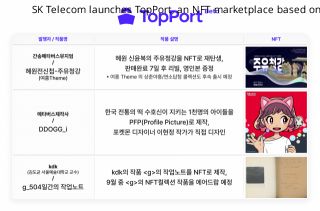SK Telecom launches TopPort, an NFT marketplace based on distributed digital asset wallets

In the case of NFT, it is possible that the service may not be well received by the public due to the lack of understanding about the service. However, if the service is well received, it could be a way for telcos to increase their presence in the digital world and tap into new markets.
SK Telecom has launched an open beta service of TopPort, an NFT marketplace based on distributed digital asset wallets.
SK Telecom plans to activate the platform through NFT gifts, auctions, and community services. SK Telecom provides NFT collection composition, publishing, and community management functions to professional NFT creators.
It supports buyers to easily make wallets and purchase NFT works without expertise. SKT has improved the convenience of customers by further shortening the purchasing stage such as subscribing to cryptocurrency exchanges, accessing cryptocurrency, purchasing cryptocurrency, etc. and by adopting KRW payment through NFT transaction method.
SKT has been developing related technologies such as web browser embedded wallets by signing a joint business agreement with AhnLab Blockchain Company and Atomrigs Lab in July this year.
Topport is available in various operating systems such as Windows, MacOS, Android, iOS, and various browsers such as Chrome, Safari, and Edge.
SKT expects that users will be able to use the wallet service easily and safely by supporting recovery in the event of a key loss without storing the user's private key at the Web3 wallet service.
Users can use blockchain technology to mint NFT by granting unique asset information. Oh Se-hyun, head of SK Telecom's Digital Asset CO, said, "NFT Marketplace is a representative service of the Web3 era where users directly own and manage all data. We will continue to develop services to respond to the Web3 market in the future."
Telcos are destined to constantly knock on the door of the consumer market to avoid becoming a dumb pipe. However, because the implementation speed is slow, it is not uncommon to open the door after the trend has passed.
